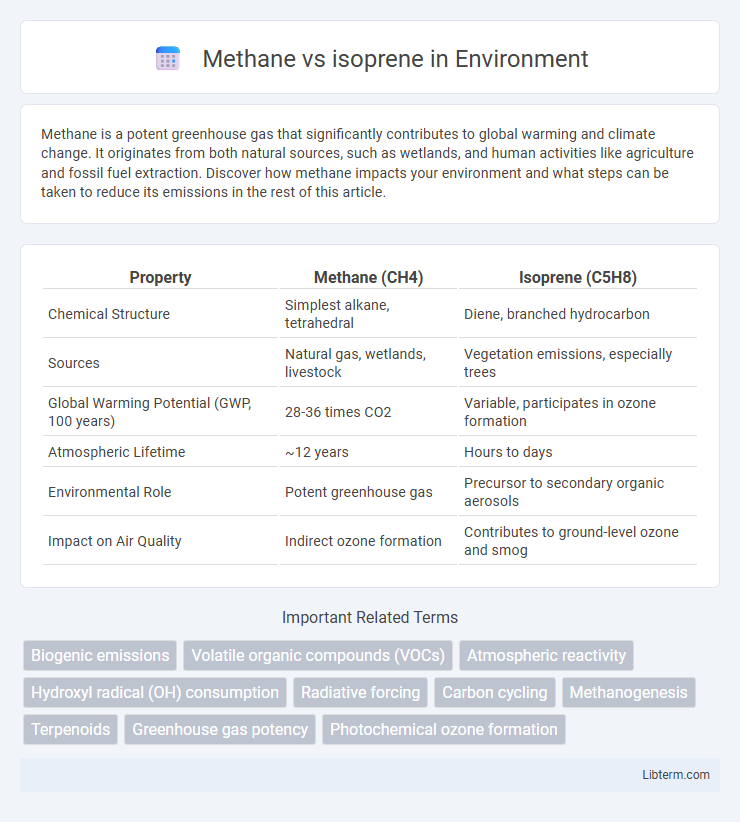Methane is a potent greenhouse gas that significantly contributes to global warming and climate change. It originates from both natural sources, such as wetlands, and human activities like agriculture and fossil fuel extraction. Discover how methane impacts your environment and what steps can be taken to reduce its emissions in the rest of this article.
Table of Comparison
| Property | Methane (CH4) | Isoprene (C5H8) |
|---|---|---|
| Chemical Structure | Simplest alkane, tetrahedral | Diene, branched hydrocarbon |
| Sources | Natural gas, wetlands, livestock | Vegetation emissions, especially trees |
| Global Warming Potential (GWP, 100 years) | 28-36 times CO2 | Variable, participates in ozone formation |
| Atmospheric Lifetime | ~12 years | Hours to days |
| Environmental Role | Potent greenhouse gas | Precursor to secondary organic aerosols |
| Impact on Air Quality | Indirect ozone formation | Contributes to ground-level ozone and smog |
Introduction to Methane and Isoprene
Methane is a simple hydrocarbon with the chemical formula CH4, primarily produced by natural processes such as anaerobic decomposition in wetlands and anthropogenic activities like fossil fuel extraction. Isoprene, a volatile organic compound with the formula C5H8, is mainly emitted by plants and trees, playing a key role in atmospheric chemistry and forming secondary organic aerosols. Both gases influence air quality and climate, with methane acting as a potent greenhouse gas and isoprene contributing to ozone formation and particulate matter in the troposphere.
Chemical Structure and Properties
Methane (CH4) is a simple alkane with a tetrahedral geometry consisting of one carbon atom bonded to four hydrogen atoms, making it non-polar and chemically stable with a high bond dissociation energy. Isoprene (C5H8) is a conjugated diene featuring two double bonds in a 2-methyl-1,3-butadiene structure, resulting in increased reactivity and the ability to participate in polymerization reactions due to its conjugated pi-electron system. The difference in bond types and molecular complexity gives methane low reactivity and isoprene higher chemical reactivity, volatility, and a key role as a building block in natural rubber synthesis.
Natural Sources of Methane and Isoprene
Methane primarily originates from anaerobic decomposition in wetlands, termites, and ruminant digestion, making wetlands the largest natural source contributing approximately 70% of global methane emissions. Isoprene is predominantly emitted by terrestrial vegetation, especially broadleaf trees like oaks and eucalyptus, contributing roughly 500 million tons annually to the atmosphere and significantly influencing tropospheric chemistry. Both compounds play critical roles in atmospheric processes, with methane acting as a potent greenhouse gas and isoprene affecting oxidative capacity and secondary organic aerosol formation.
Anthropogenic Emissions: Human Impact
Methane (CH4) and isoprene are significant components of atmospheric chemistry with distinct anthropogenic sources affecting air quality and climate. Methane emissions primarily originate from fossil fuel extraction, livestock farming, and waste management, contributing substantially to greenhouse gas concentrations and global warming. Isoprene emissions, while largely natural from vegetation, are influenced indirectly by human activities such as deforestation and urbanization, altering regional air quality and ozone formation through interactions with anthropogenic pollutants.
Atmospheric Lifetime and Reactivity
Methane has an atmospheric lifetime of about 12 years, making it a relatively long-lived greenhouse gas with moderate reactivity primarily involving hydroxyl radicals (OH). Isoprene, a biogenic volatile organic compound, exhibits a much shorter atmospheric lifetime of approximately 1 to 2 hours due to rapid reactions with OH radicals and ozone. The high reactivity and short lifetime of isoprene significantly influence tropospheric ozone formation and secondary organic aerosol production compared to the more persistent methane.
Role in Climate Change
Methane is a potent greenhouse gas with a global warming potential approximately 28-36 times greater than carbon dioxide over 100 years, significantly contributing to climate change through trapping heat in the atmosphere. Isoprene, a biogenic volatile organic compound emitted primarily by vegetation, influences climate indirectly by participating in atmospheric chemical reactions that affect ozone formation and aerosol production. While methane directly accelerates global warming, isoprene's role is complex, involving both warming and cooling effects depending on atmospheric conditions and interactions with other pollutants.
Effects on Air Quality and Human Health
Methane, a potent greenhouse gas, contributes significantly to the formation of ground-level ozone, which exacerbates respiratory issues and cardiovascular diseases in humans. Isoprene, emitted primarily by vegetation, reacts with nitrogen oxides in the atmosphere to produce ozone and secondary organic aerosols, impacting air quality and triggering asthma and other lung conditions. Both compounds influence atmospheric chemistry differently but collectively worsen air pollution and pose risks to human health.
Global Distribution and Emission Patterns
Methane emissions predominantly originate from wetlands, agriculture, and fossil fuel extraction, with significant sources concentrated in tropical and high-latitude regions. Isoprene, a volatile organic compound mainly emitted by vegetation, exhibits a global distribution aligned with forested and tropical areas, especially in the Amazon Basin and Southeast Asia. Methane's atmospheric lifetime of about 12 years contrasts with isoprene's rapid atmospheric reactivity, resulting in distinct spatial and temporal emission patterns influencing regional air quality and climate processes.
Methods of Detection and Measurement
Methane detection primarily employs gas chromatography and infrared spectroscopy, which offer high sensitivity for monitoring its concentration in the atmosphere. Isoprene measurement often utilizes proton-transfer-reaction mass spectrometry (PTR-MS) due to its ability to detect volatile organic compounds with rapid response times. Both methods require calibration standards and hold importance in environmental monitoring to assess air quality and biogenic emissions.
Mitigation Strategies and Future Perspectives
Methane mitigation strategies focus on reducing emissions from agriculture, fossil fuel extraction, and waste management through improved practices and technology such as methane capture and renewable energy integration. Isoprene emissions, primarily from vegetation, are more challenging to control but can be managed by enhancing urban green spaces with low-isoprene-emitting plant species and optimizing land use. Future perspectives include advanced monitoring systems and modeling techniques to better understand atmospheric interactions and develop targeted approaches for balancing methane reduction and isoprene-related air quality impacts.
Methane Infographic

 libterm.com
libterm.com